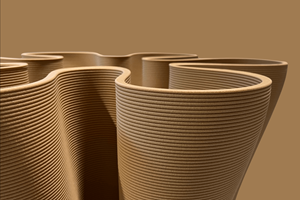Basic, multiaxial composite material offerings balance processing and performance
CAMX 2025: Saertex USA is a domestic materials partner offering reliable high-quality composite reinforcements and local service, from 150-inch-wide multiaxial fabrics with Chop to comprehensive material ranges.
Share
Source | Saertex USA
Saertex USA (Huntersville, N.C., U.S.) is highlighting its U.S.-made, high-performance composite solutions supporting key industries from transportation to marine. This includes the company’s multiaxial fabrics with chopped strand mat (or “Chop”), carbon and glass fiber material lines, a displayed motorcycle hood and an emphasis on Saertex’s marine solutions.
Manufactured at its North Carolina facility, Saertex 150" wide multiaxial fabrics with Chop are reported to be the widest reinforcements available on the market, enabling more efficient processing and fewer seams, all without compromising mechanical properties. The fabrics are ideal for large-scale composites manufacturing, and come in a combination of continuous fibers and a chop strand mat.
Produced locally for fast lead times and quality assurance, Saertex’s Carbon and Glass Basic Lines are made in the U.S., versatile, cost-effective and optimized for a range of infusion and closed-mold processes. These reinforcements are ideal for customers looking to balance performance, availability and price.
A dynamic example of advanced composite design and structural performance, is a three-wheeled motorcycle hood. It highlights Saertex USA’s expertise in fabric designs for lightweight, complex-shaped parts. It also features the company’s SAERcore product for added strength, form adaptability and process efficiency in molding operations.
Finally, Saertex is spotlighting its marine solutions — trusted by boatbuilders for their durability, lightweight performance and processing efficiency in both structural and aesthetic parts. Whether a customer requires high-volume production or custom builds, Saertex says its portfolio is built to meet specific needs.
Related Content
-
Carbon fiber, bionic design achieve peak performance in race-ready production vehicle
Porsche worked with Action Composites to design and manufacture an innovative carbon fiber safety cage option to lightweight one of its series race vehicles, built in a one-shot compression molding process.
-
Sulapac introduces Sulapac Flow 1.7 to replace PLA, ABS and PP in FDM, FGF
Available as filament and granules for extrusion, new wood composite matches properties yet is compostable, eliminates microplastics and reduces carbon footprint.
-
Welding is not bonding
Discussion of the issues in our understanding of thermoplastic composite welded structures and certification of the latest materials and welding technologies for future airframes.
Related Content
Carbon fiber, bionic design achieve peak performance in race-ready production vehicle
Porsche worked with Action Composites to design and manufacture an innovative carbon fiber safety cage option to lightweight one of its series race vehicles, built in a one-shot compression molding process.
Read MoreSulapac introduces Sulapac Flow 1.7 to replace PLA, ABS and PP in FDM, FGF
Available as filament and granules for extrusion, new wood composite matches properties yet is compostable, eliminates microplastics and reduces carbon footprint.
Read MoreWelding is not bonding
Discussion of the issues in our understanding of thermoplastic composite welded structures and certification of the latest materials and welding technologies for future airframes.
Read MoreBladder-assisted compression molding derivative produces complex, autoclave-quality automotive parts
HP Composites’ AirPower technology enables high-rate CFRP roof production with 50% energy savings for the Maserati MC20.
Read MoreRead Next
Next-gen fan blades: Hybrid twin RTM, printed sensors, laser shock disassembly
MORPHO project demonstrates blade with 20% faster RTM cure cycle, uses AI-based monitoring for improved maintenance/life cycle management and proves laser shock disassembly for recycling.
Read MoreScaling up, optimizing the flax fiber composite camper
Greenlander’s Sherpa RV cab, which is largely constructed from flax fiber/bio-epoxy sandwich panels, nears commercial production readiness and next-generation scale-up.
Read MoreCutting 100 pounds, certification time for the X-59 nose cone
Swift Engineering used HyperX software to remove 100 pounds from 38-foot graphite/epoxy cored nose cone for X-59 supersonic aircraft.
Read More






